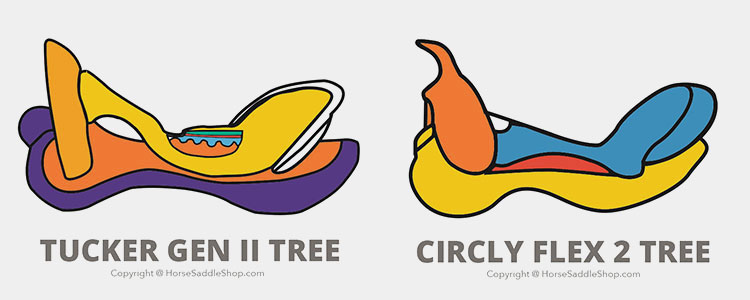Differences between Saddle Trees
Differences between saddle trees
You may be dazzled by the styling of a particular saddle, but what you can't see--the tree underneath--is one of the most important elements to selecting the saddle that's right for you.
The term saddle tree refers to the foundation of the saddle, and informing yourself about the pros and cons of each type of saddle tree will be a great benefit.
THE WOOD TREE
Ever since man decided that just riding around on a saddle blanket wasn't good enough, saddle trees have been made from wood (hence the term "tree"). As modern as we think we are, wood trees are still serving their purpose. But what's covering the wooden parts after they're formed together is what makes the wooden tree so useful:
- Rawhide: After a saddlemaker has prepared the wood tree, it's covered in wet rawhide that shrinks and coats the wood. The use of rawhide makes the tree extremely durable and a bit flexible, allowing it to absorb shock and withstand hard work, as well as protect the tree from sweat and weather.
- Bullhide: Bullhide is exactly what it sounds like---the skin of a bull, which is generally thicker and denser than rawhide. It is believed to make a stronger tree, yet because of the density, allows the tree to mold to the horse more quickly than rawhide. Bullhide is the "premier" covering for rawhide-covered trees.
- Fiberglass Covered: Fiberglass is a recent addition to saddle making. It proves itself to be a very durable material and without question protects the wood underneath. Fiberglass is a more economical option than bull hide or rawhide, the price of which is more at the mercy of the economy.
THE FLEX TREE
When first introduced, the saddle with the flexible tree was looked upon with much skepticism. But today flex trees seem to be making a lot more satisfied horses. Flexible trees retain their rigid fork and cantle, but allow the bars of the saddle to flex and conform to the horse's movement.
You can read more about flex trees here. Take a look at Circle Y's Flex2 information (pictured on right)here or Tucker's new GEN II flexible tree (pictured on left)here.

THE RALIDE TREE
The term Ralide refers to both the material and the U.S. trademarked manufacturer of the material. Ralide is a synthetic type of polyethylene. The trees are manufactured using a molding process, which lowers production costs and makes Ralide trees more economical. Ralide, like its wood competitor, proves to be durable, flexible, and strong.